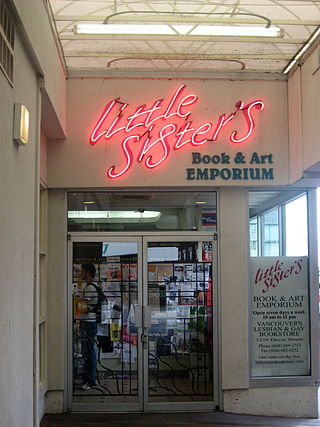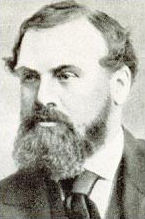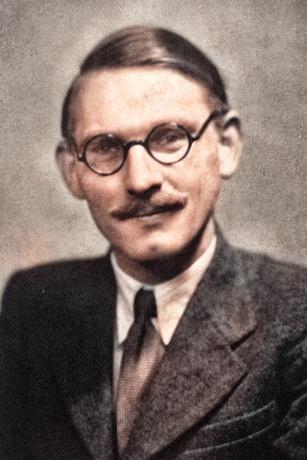
Thomas Carlyle was a British essayist, historian, and philosopher from the Scottish Lowlands. A leading writer of the Victorian era, he exerted a profound influence on 19th-century art, literature, and philosophy.

Christopher Darlington Morley was an American journalist, novelist, essayist and poet. He also produced stage productions for a few years and gave college lectures.
This Ain't the Rosedale Library was an independent bookstore located in Toronto, Ontario. Located in the Church and Wellesley neighbourhood for much of its history, the store moved to Kensington Market in May 2008, but closed in June 2010. Its name referred to Rosedale, an affluent neighbourhood of the city.

Little Sister's Book and Art Emporium, also known as Little Sister's Bookstore, but usually called "Little Sister's", is an independent bookstore in the Davie Village/West End neighbourhood of Vancouver, British Columbia, Canada. The bookstore was opened in 1983 by Jim Deva and Bruce Smyth, and its current manager is Don Wilson.

George Whitman was an American bookseller who lived most of his life in France. He was the founder and proprietor of Shakespeare and Company, the celebrated English-language bookstore on Paris's Left Bank. He was a contemporary of writers such as Allen Ginsberg, Anaïs Nin, and Lawrence Durrell, as well as a lifelong friend of the poet Lawrence Ferlinghetti.

William Alfred Westropp Foyle (1885–1963) was a British bookseller and businessman who co-founded Foyles bookshop in 1903 with his brother Gilbert Foyle.

Shakespeare and Company is an English-language bookstore opened in 1951 by George Whitman, located on Paris's Left Bank.

One, Two, Buckle My Shoe is a work of detective fiction by Agatha Christie first published in the United Kingdom by the Collins Crime Club in November 1940, and in the US by Dodd, Mead and Company in February 1941 under the title of The Patriotic Murders. A paperback edition in the US by Dell books in 1953 changed the title again to An Overdose of Death. The UK edition retailed at seven shillings and sixpence (7/6) while the United States edition retailed at $2.00.

Parnassus on Wheels is a 1917 novel written by Christopher Morley and published by Doubleday, Page & Company. The title refers to the Mount Parnassus of Greek mythology; it was the home of the Muses.

The Oscar Wilde Bookshop was a bookstore located in New York City's Greenwich Village neighborhood that focused on LGBT works. It was founded by Craig Rodwell on November 24, 1967, as the Oscar Wilde Memorial Bookshop. Initially located at 291 Mercer Street, it moved in 1973 to 15 Christopher Street, opposite Gay Street.

The Gotham Book Mart was a famous Midtown Manhattan bookstore and cultural landmark that operated from 1920 to 2007. The business was located first in a small basement space on West 45th Street near the Theater District, then moved to 51 West 47th Street, then spent many years at 41 West 47th Street within the Diamond District in Manhattan, New York City, before finally moving to 16 East 46th Street. Beyond merely selling books, the store virtually played as a literary salon, hosting meetings of the Finnegans Wake Society, the James Joyce Society, poetry and author readings, art exhibits, and more. It was known for its distinctive sign above the door which read, "Wise Men Fish Here". The store specialized in poetry, literature, books about theater, art, music and dance. It sold both new books as well as out-of-print and rare books.

Being the site of military battles, deadly duels, assassinations, untimely deaths, and other associated tragedies, there are a number of reportedly haunted locations in Washington, D.C., the capital city of the United States.

New Beacon Books is a British publishing house, bookshop, and international book service that specializes in Black British, Caribbean, African, African-American and Asian literature. Founded in 1966 by John La Rose and Sarah White, it was the first Caribbean publishing house in England. New Beacon Books is widely recognized as having played an important role in the Caribbean Artists Movement, and in Black British culture more generally. The associated George Padmore Institute (GPI) is located on the upper floors of the same building where the bookshop resides at 76 Stroud Green Road, Finsbury Park, London.

Frederic Chapman was a publisher of the Victorian era who became a partner in Chapman & Hall, who published the works of Charles Dickens and Robert Browning and Elizabeth Barrett Browning, among others.

Katharine Sarah Macquoid was a British novelist and travel writer, who published over 65 works. In addition to writing books, many of Macquoid's stories were published in magazines, the first story appearing in a publication called Welcome Guest, in 1859. Her first novel, A Bad Beginning: a story of a French marriage (1862), was successful. Probably her best story was Patty (1871).

John Muriel, also known as "John St. Clair Muriel", was a British countryman, teacher, novelist, and biographer from a middle-class East Anglian background who wrote as "Simon Dewes" and "John Lindsey".
Anton Zwemmer (1892–1979) was a Dutch-born British bookseller, book distributor, art dealer, publisher and collector who founded Zwemmer's Bookshop and the Zwemmer Gallery in London. He was a "friend and patron of many leading artists", from Picasso to Henry Moore and Wyndham Lewis, and he played "an important role in spreading knowledge and appreciation of modern art" in Britain during the 1920s and 1930s.

Frank Cheshire (1896–1987) was an Australian bookseller and publisher. His bookshop in Little Collins Street, Melbourne was described as a "gathering place for all interested in books and literature" in the mid-twentieth century. His publishing firm, F. W. Cheshire Pty. Ltd. published school textbooks and dominated that market in the state of Victoria for many years. It "began a new era in publishing" when it published Australian text books for Australian schools instead of importing them from Britain. The firm also published a number of general trade bestsellers such as Alan Marshall's I Can Jump Puddles, Robin Boyd's The Australian Ugliness and Joan Lindsay's Picnic at Hanging Rock and "gave many Australian writers their first start".
The University of New South Wales Press Ltd. is an Australian academic book publishing company launched in 1962 and based in Randwick, a suburb of Sydney. The ACNC not-for-profit entity has three divisions: NewSouth Publishing, NewSouth Books, and the UNSW Bookshop, situated at the Kensington campus of the University of New South Wales, Sydney. The press is currently a member of the Association of University Presses.
The Greenwich Village Bookshop Door (1920–25) separated the back office from the main area of Frank Shay's Bookshop in Greenwich Village from 1920 until 1925, where it served as an autograph book for nearly two hundred and fifty authors, artists, publishers, poets, and Bohemian creatives. Notable signatories include Upton Sinclair, the Provincetown Players, John Sloan, Susan Glaspell, Theodore Dreiser, and Sinclair Lewis. The door has been held in the permanent collections of the Harry Ransom Center at the University of Texas at Austin since it was purchased in 1960.















